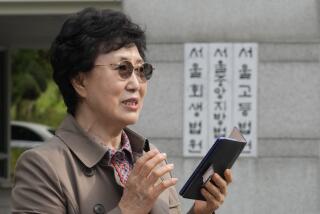S. Korea Tries to Take Care of Its Own With Domestic Adoptions
SEOUL — South Korea, which pioneered inter-country adoption after the Korean War nearly half a century ago, has been dramatically cutting back the number of children it sends overseas each year.
Adoptions have dropped from a peak of more than 8,000 in 1986 to about 1,800 in 1998, and the government wants to phase them out entirely.
South Korea, once the No. 1 source of foreign-born children adopted by American families, has sunk to a distant third, behind Russia and China.
The deliberate change in policy, aimed at encouraging domestic adoptions, was motivated in part by embarrassment that an increasingly prosperous country was sending so many of its children away. Yet the policy has come under renewed focus for two reasons: Domestic adoptions have not caught on as much as hoped, and the number of abandoned children has soared since a financial crisis knocked South Korea into a severe recession in late 1997.
Even before the crisis, many abandoned children languished in institutions for years, caught in legal limbo. Although they were deserted, they could not be put up for adoption because their families did not sign waivers.
There are now 17,000 children in public orphanages throughout the country and untold numbers at private institutions.
Domestic adoptions by Koreans, while on the uptick, are still rare in this society that clings to patriarchal bloodlines: 1,412 Korean children were adopted within Korea last year. Older and handicapped children are particularly difficult to place domestically.
The government “doesn’t want to sell the children overseas, but they don’t want to do anything about them either,” said Park Young Sook, a private citizen who has formed a network of families who take neglected children into their own homes at their own expense. Such foster homes are rare in Korea.
Virtually the only Korean children being sent overseas for adoption these days are infants born to unwed mothers. Korean families are given first priority in adopting such babies, and about half those sent overseas have handicaps, were premature or have other special needs, said Lee Hyon Ju, spokesman for Holt Children’s Services in Seoul, one of four agencies that handle foreign adoptions in Korea.
The Holt agency began when an American couple, Harry and Bertha Holt, blazed the inter-country adoption trail by adopting eight South Korean orphans in the 1950s after the Korean War. There are now well over 50,000 adoptees from Korea in the U.S.
Since the Seoul Olympics in 1988, however, South Korea has set a goal of reducing the number of children it sends abroad.
“There was much criticism that we must take care of our own,” said Lee, the spokesman for Holt, which also handles domestic adoptions. The country set an unofficial quota of about 2,000 children a year for overseas adoptions and aimed to halt them altogether by 1996.
The goal was not met, however. Now, the government is striving to reduce overseas adoptions by 3% each year until they are eliminated, said Lee Chang Jun, deputy director of the Ministry of Health and Welfare’s Infant Nursery and Child Welfare Division.
Lee said racism was one of the issues that led to the new policy.
“I’ve met many parents of U.S. adoptees, and I get the feeling the child is lucky to have gone to foreign parents,” Lee said. “But if you look different and there is racism [overseas], if it’s possible, it would be better to give the children to parents who look similar, with the same skin color and same culture.”
Susan Cox, a spokeswoman for Holt’s U.S. arm in Eugene, Ore., applauded the Korean effort to encourage domestic adoptions. “It is a good thing,” said Cox, who was adopted from Korea when she was 4 years old.
But, she added, “the objective is for children to have families. Children shouldn’t have to wait forever for that to happen.”
Many U.S. families would be open to adopting older children from Korea, said Margie Perscheid of Virginia, who has adopted Korea-born children and founded a support group known as Korean Focus for Adoptive Families.
“It’s difficult not to sound like vultures hovering over,” Perscheid said. “But there’s clearly a desire to help if children need families.”
More to Read
Sign up for Essential California
The most important California stories and recommendations in your inbox every morning.
You may occasionally receive promotional content from the Los Angeles Times.










